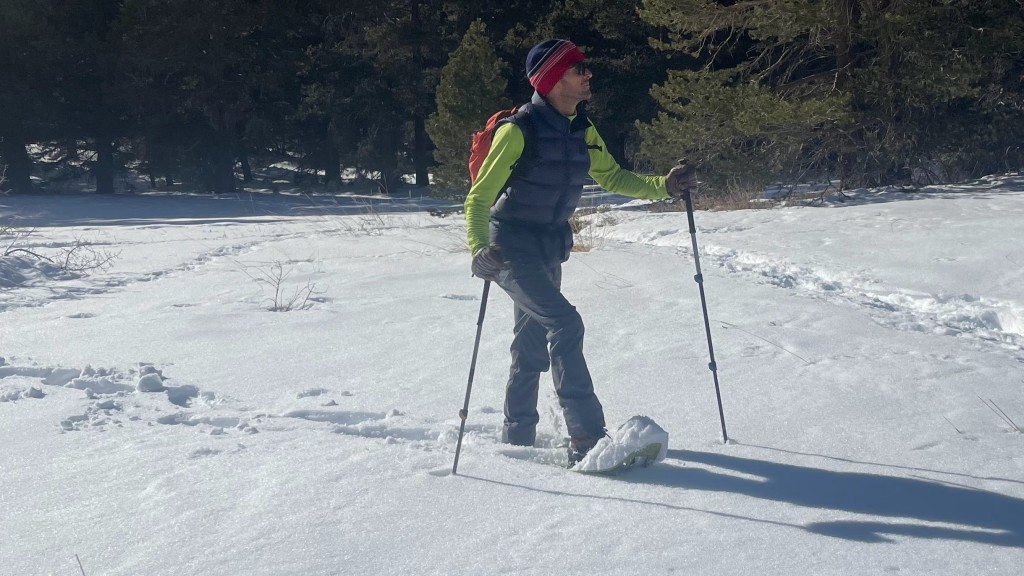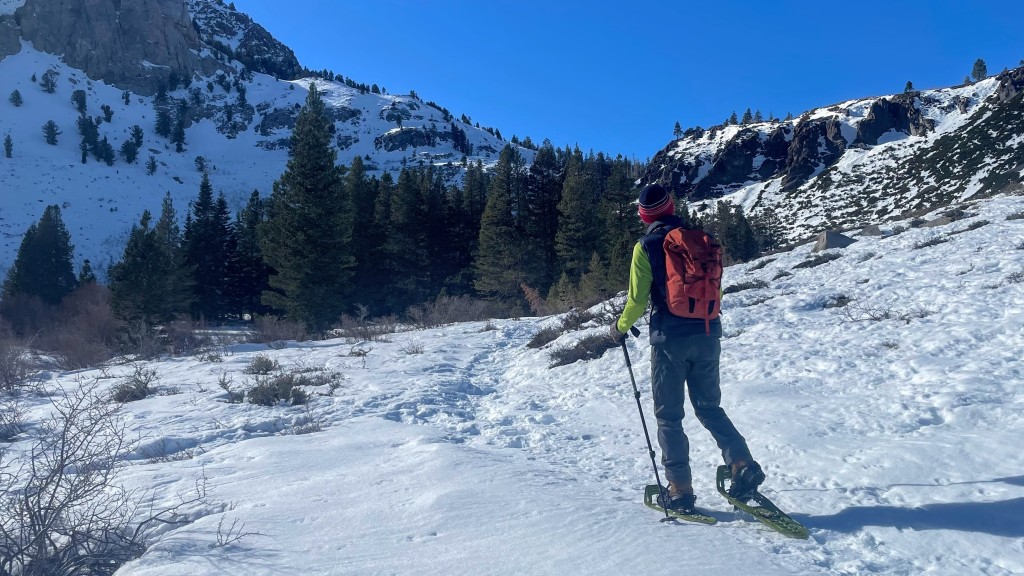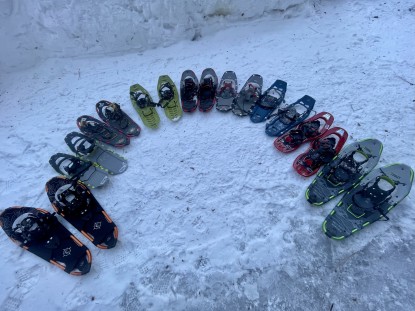Our Verdict
Our Analysis and Test Results
One-piece plastic decks have been around for well over a decade in snowshoes, but very few companies were making them. We are excited to see a major company like Atlas using this technology. This type of snowshoe construction tends to be lighter overall with better traction. Read on to see if the Helium Trail lives up to this potential.
Performance Comparison
Flotation
This is the reason you're reading a snowshoe review — you don't want to be wallowing around in hip-deep snow this winter! The most important factor in flotation is the surface area of the snowshoe. Our measuring method yielded 207 square inches of surface area for the Helium Trail, which is about what we expect for a model that's 27 inches long.
One characteristic that can enhance surface area is rigidity or stiffness. Models with a metal frame are usually perfectly rigid fore-to-aft; plastic models can be more flexible, and that is somewhat true here. The lengthwise steel traction rails add quite a bit of stiffness, but these stop short about 8 inches from the end of the snowshoe, leaving the tail slightly flexible. Though this does detract slightly from the flotation, it helps make for a more natural stride.
Traction
Snow can be slippery. After flotation, traction is the most important snowshoe metric. After all, flotation with no traction is what skis are for. While the traction on the Helium Trail isn't bad overall, we had higher expectations. Side-by-side testing with similar one-piece plastic snowshoes showed this model slipping slightly more often.
Modern snowshoes have metal teeth, spikes, and rails underneath to add grip. The Helium Trail meets this expectation with a row of steel teeth under the toes and a pair of 14-inch serrated steel rails running lengthwise underneath. These provide some up-and-down traction but really come into play on sidehills and traverses when they engage with crusty surfaces to prevent the snowshoe from sliding out. The under-toe teeth face forward at an angle; our testers speculated that they'd provide more grip if they pointed straight down.
Snowshoes with a single-piece plastic frame and deck construction have an additional traction advantage: fins, ridges, and paddles molded into the deck. The Helium has these, both as an extension of the rails and perpendicular to the direction of travel, to enhance uphill and downhill traction. Again, we think that if the fins in the rear of the snowshoe pointed straight down (and were perhaps deeper), they might offer more traction.
Stride Ergonomics
When it comes to how pleasant or unpleasant it is to walk in a pair of snowshoes, several factors come into play. These include, but are not limited to, how the binding is attached to the deck and the overall shape of the deck. The Helium Trail goes with a hinged attachment for the binding to deck attachment. Considering that this is the “Trail” model of the Atlas Helium line, it wouldn't be ridiculous for these to have a strapped attachment. That being said, the hinged attachment performs better on gnarly, steep, or technical ground, so using it on this snowshoe adds versatility.
The last 8 inches of the tail on the Helium are slightly flexible. While this does slightly chip away at their functional flotation, we think that it slightly improves performance on hardpacked snow and groomed trails, again increasing versatility.
Another factor to consider with this model is weight. Though that's not a metric in our test, we do measure and note it with the specs. The Helium lives up to its name; it's among the lightest in our review and lighter than any other 25 or 26-inch model. Adding weight to your feet does not lead to a more comfortable or natural stride, and we appreciate that this snowshoe adds the least.
Ease Of Use
The Helium Trail is easy to use. It passed our “first-time user” test with flying colors on several occasions. Many of our testers prefer to see rubber pin-in-hole type straps used throughout a snowshoe binding because they tend to be quite durable and intuitive to use. The Helium Trail delivered on this count.
The forefoot is wrapped in a flexible rubber “net” on the Helium Trail. This cage is secured to the foot with two rubber straps. The ends of the rubber straps are flared and textured for easy gripping. If you're mainly using the same boots with your snowshoes, you can leave these in place, just adjusting the heel strap to enter and exit the binding.
The heel of the binding features the same rubber pin-in-hole type of strap. The strap is secured with a plastic buckle that flips open and stays that way for easy loosening. The last thing we look at for this metric is heel lifters. The Helium has them, and we found them easy to engage and disengage without too much resistance in either direction.
Bindings
Here we look at the bindings from both a comfort and security perspective. Too often, these two attributes exist in opposition. Bindings that are comfortable are sometimes more likely to fall off your foot — the last thing you want on a stormy day. Bindings that hang on tenaciously can sometimes create pressure points or restrict circulation, which is not what you need when it's cold outside.
The Helium Trail features bindings that do everything we want. They're comfortable, and the rubber forefoot net (Atlas calls this the “Wrapp Stretch” binding) distributes binding pressure evenly around the foot. The net is offset towards the inside of the foot. This means that hikers with boots that are both large and soft could feel pressure from the straps.
In the security department, the front straps are pin-in-hole, which our testers have used for years and experienced no problems — and we didn't with the Helium either. As mentioned above, the heel is secured with a plastic buckle, and as long as this is in the “closed” position, hikers should have no problems.
Should You Buy the Atlas Helium Trail?
The Helium Trail is a well-rounded snowshoe and can go beyond the kind of terrain its name — “Trail” — implies. Because this snowhoe performs well both on the trail and off, we think that most hikers who need flotation will be well-served by this model.
What Other Snowshoes Should You Consider?
Readers who are mainly headed to steep or mountainous terrain in the winter could be better served by the MSR Lightning Ascent, which is designed for exactly that kind of ground. Another model with the all-around performance of the Helium Trail is the MSR Evo Trail. Though it has less flotation, this model does well on trails and can dabble in the alpine.













